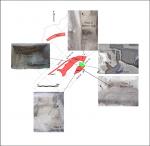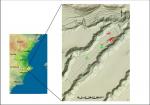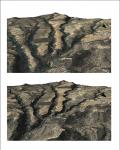Summary (English)
The various updates carried out in 2010/2011 in the Neolithic dig site at Mas d’Is have furthered knowledge and understanding of the first agricultural communities on the Iberian Peninsula. The previous campaigns had revealed the existence of some enormous structures in the Northern extremity of the dig site. The chronological sequence is now clear, thanks to the presence of fragments of pottery and tools, a complete set of lithics, and personal adornments made of stone as well as bone. These chronological details of the dig site match up with advances in the understanding of the paleoambient of the Les Puntes zone thanks to a detailed sedimentological study.
Important osteological remains have been uncovered, which inform us about the farming and hunting practices of the first agriculturalists in the valleys of Alcoy, in one of the oldest open-air dig sites on the Iberian Peninsula (circa 5,600 BC). The fantastic find is important as it demonstrates the variety of dommesticated and wild species and the practical management of livestock.
The spatial distribution of the finds is not uniform, so zones with a greater concentration of pottery can be found, as well as areas of abundant flint and bone. The areas with a high concentration of stone bracelets are without doubt the most relevant.
We have managed to expose an important part of trench 4, which has allowed us to establish the original morphology of this area and its relation to the rest of the surrounding areas. The documenting of a new combustion structure within trench 4 evidences its habitual use for specialised activities.
In the lower levels of this negative structure various sherds of pottery have been found, probably of Italian origin; these materials give provenance to the early occupation of Mas d’Is by the first agriculturalists, who expanded from the South of Italy towards the Iberian Peninsula. The discussion is ongoing about the path that these ceramics and their carriers took to arrive at Serpis valleys. Although the maritime route seems likely, it does not show if the voyage was via the Gulf of Genoa or the North African coast.
(translation by Florence Lilley)
- Agustín Díez Castillo, Joan Bernabeu Aubán y Teresa Orozco Köhler
Director
- Joan Bernabeu Aubán y Teresa Orozco Köhler (Departamento de Prehistoria y Arqueología. Universidad de Valencia)
Team
- Agustín Díez Castillo y Sonia López Melón
Research Body
- Universidad de Valencia; Diputación Provincial de Alicante; Museo Arqueológico Municipal Camil Visedo Moltó
Funding Body
- Universidad de Valencia






![Download [PDF]](/excavation/skins/fasti/images/results/download_sml.png)

